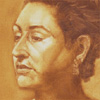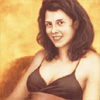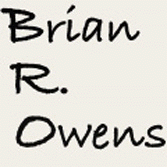 |
 |
 |
| What is an Oil Drawing (a.k.a. an Underpainting)? by Brian Owens An "oil drawing" is essentially a painting done in one color. It's called a drawing because it resembles a drawing when it is done. Drawings are often (but not always) done in one color, like a charcoal drawing. Usually, an oil drawing is done on canvas or board just as a full-color painting would be. Sometimes, the Masters of traditional painting used this method to help think through their paintings, especially large, complex compositions. They called it "underpainting". They would paint an entire scene in one color. A monochomatic underpainting allowed them to work out the details of the composition and develop a very precise drawing before other paint colors were applied. The Masters of traditional painting were not only interested in where people and objects should placed within a scene. They also wanted a plan for how light or dark everything would be, from the darkest dark to the lightest light. For them, the underpainting (also called "grisaille") was a powerful method. It helped them break a fairly large and difficult task into a series of smaller, more manageable tasks. The Masters of traditional painting sought to understand the "mechanism of perception". They were in the business of creating illusions; of decieving the viewer into seeing a 3-dimensional scene on a surface that was actually flat. Naturally, we see in color. But, they knew that lightness and darkness reveal most of what's happening on a surface, be it the surface of a table or the surface of someone's face. Underpainting was one way of setting the stage for their illusions. So reliant are we on our vision; so powerful were their methods and techniques, that the illusion of the completed painting persists even when the viewer is fully aware of the techniques that were used. Regardless of whether they used an under-painting or not, the Masters had a solid plan for their paintings before substantive work began. The notion that they simply painted their visions spontaneously without analysis is completely false. For them, an underpainting was not a crutch but a powerful tool. If they were still here, they would regard Marvin Mattelson's sage advice to his students with approval: "Begin with the end in mind". Today, the Oil Drawing (or under-painting) has it's own appeal. We love it for its simplicity; its appearance of brevity and its warmth. Traveling to Clients Within Florida, I am most active in Volusia County, Seminole County and Orange County. However, I consider Florida and Georgia to be a "local" area and I travel to meet with clients at their homes. Do you live outside this area? Please call anyway. My studio and residence is located just north of Orlando in central Florida, but I have worked for clients as far away as Virginia. Prices and additional Information Portrait artists are "up front" about portrait pricing, which is largely a function the market, historic pricing norms, the fame of the artist and the size and complexity of the portrait, not the number of hours it takes to complete it. Some artists post their price schedule online. I prefer to send my price sheet upon request. I am also available to paint or draw children's portraits, family portraits and group portraits. If you would like a more independent source of information (including pricing), I highly recommend the back issue of American Artist, April 1999, entitled "Portrait Painting Today". It focuses on oil portraiture in general, not "oil drawing", but it is a great resource. To obtain a copy, vist My American Artist. Click on "Online Store", click on "American Artist Issues", click on page 2 and scroll down to April, 1999: "Portrait Painting Today". It costs about $5. |


